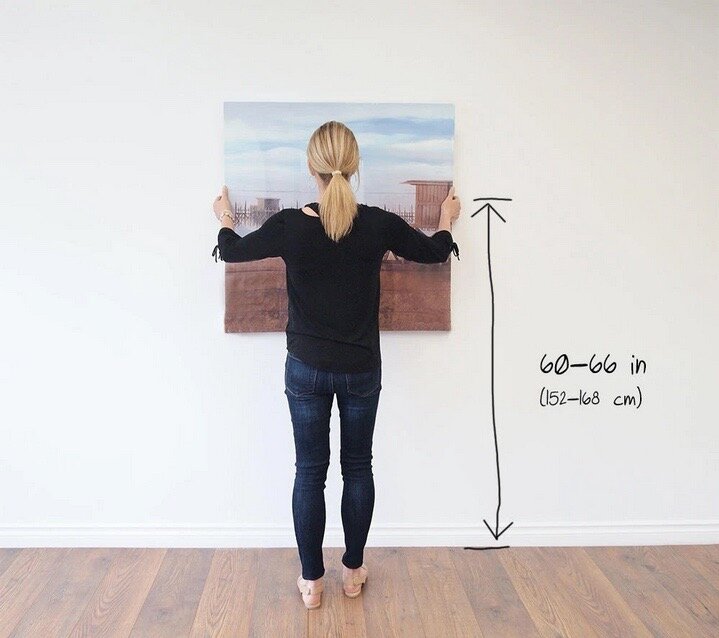Your cart is currently empty!

Hanging wall art should feel simple, right? Hammer, nail, done! But the truth is, many people make some pretty common mistakes that can make even the most beautiful artwork look… well, off. From crooked placements to wrong height or clashing colors, small missteps can throw off the entire vibe of a room.
Whether you’re displaying an abstract oil painting, a gallery wall, or a bold canvas, here’s how to avoid the most typical art hanging mistakes—and make your home look like a curated masterpiece.
1. Hanging Art Too High or Too Low
Let’s start with the classic mistake: hanging artwork too high (or sometimes way too low).
🎯 The Fix:
A good rule of thumb is to place the center of the artwork at eye level, which is roughly 57–60 inches from the floor. This is the standard used in galleries and museums.
If you’re hanging art above a piece of furniture, like a sofa or a bed frame, keep the bottom of the artwork about 6–10 inches above the furniture line.
Trust me, even a stunning oil painting can look awkward if it’s floating too high or sitting too low.
2. Using Art That’s Too Small (or Too Big)
Scale is everything. A tiny framed picture on a big, empty wall just feels lost, while an oversized painting in a narrow hallway can feel overwhelming.
📐 The Fix:
- For large blank walls, go big or group small ones together to form a gallery.
- When placing art above furniture, choose a piece that’s about two-thirds the width of the furniture below it.
If you’re unsure, abstract oil paintings often come in various sizes, which makes them perfect for scaling up or down depending on your wall size.
3. Skipping Proper Spacing
Ever see a gallery wall where everything feels crammed or uneven? Yeah, that’s what poor spacing does.
🔧 The Fix:
Keep 2–4 inches of space between frames for a clean and cohesive look. For multi-panel wall art (like diptychs or triptychs), the spacing should feel intentional—not too tight and not overly gapped.
4. Ignoring the Room’s Style and Color Palette
Sometimes, people hang a bold red oil painting in a calm, neutral-toned bedroom. The result? Visual chaos.
🎨 The Fix:
Consider your room’s overall vibe before choosing wall art. If your home is minimalist or Nordic, textured or neutral-toned abstract oil paintings work best. For a vintage interior, go with rich colors and detailed frames. Let your art complement—not compete with—your furniture and color palette.
5. Not Using the Right Hardware
Push pins, masking tape, and thumbtacks? That’s a no-go.
🛠️ The Fix:
Use the right hanging hardware for your wall type (drywall, brick, plaster, etc.). For heavier pieces like oil on canvas, invest in picture hooks or wall anchors.
And always use a level. Hanging your artwork crooked by even a few degrees is noticeable (and slightly irritating to look at, let’s be honest).
6. Hanging Everything in a Straight Line
While symmetry can be lovely, always lining up your art horizontally or vertically can sometimes make your space feel rigid or boring.
🔄 The Fix:
Play with composition! Try arranging different sized artworks in asymmetrical layouts. Abstract pieces especially work well when grouped creatively.
You can sketch out a layout on paper or even tape outlines on the wall before committing to nails.
7. Forgetting About Lighting
You’ve chosen the perfect oil painting, placed it just right—but it’s stuck in a dim corner. That’s a big mood-killer.
💡 The Fix:
Add some soft lighting to spotlight your art. Wall sconces, picture lights, or even indirect floor lamps can make your wall art pop. For textured oil paintings, proper lighting also brings out depth and detail.
Final Thoughts
Hanging wall art is more than just decoration—it’s about telling your story, expressing mood, and enhancing your space. Whether you’re into abstract oil painting, minimalist line art, or statement wall murals, avoiding these small but impactful mistakes will help you show your pieces at their very best.
If you’re ready to explore unique art that fits your space and style, visit OKarty.com and browse our curated collections.